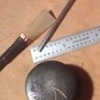If the upper octave is flat or sharp relative to the lower, the cause is usually a staple of inappropriate size. Within certain limits, the smaller the internal volume of the reed, the flatter will be the upper octave, and similarly, the larger the volume of the reed, the sharper the upper octave. The internal volume is the sum of the volume of the staple and the space between the two reed blades. The volume of the staple depends upon its length, inside diameter, and rate of taper, any or all of which may need to be adjusted to suit a given chanter. The space between the blades is determined by the width, length, inner curvature and shape of the blades. For example, a reed with parallel edges will have a greater internal volume than one with tapering edges, all other elements being equal. (Quinn)
Chanter Reed Issues
Search Tips:
- To search for a particular note, such as "D", enter "D note" (Quotes are not required).
- To find all, reload the page or delete all search terms and click "apply".
- Back D Discussions
Upper Octave is Flat or Sharp Relative to the Lower Octave (Chanter)
Upper Octave is Hard to Produce and Maintain (Chanter)
-
The upper octave may be made easier to produce and maintain by slightly thinning the blades at their lips. Removing too much cane from the tip can make the second octave more difficult to achieve. (Quinn)
Sinking Back "D" (Chanter)
-
This may be a result of leakage in the reed or of air entering the chanter at the base of the reed. If the reed leaks along it's edges, you can make them staunch with beeswax or a light smear of Soboâ„¢ glue. A short length of thread coated with beeswax may be placed around the bottom of the staple to eliminate leaks in the reed socket. The sinking D may also be caused by reed tips which are too thin. Often it is necessary to experiment with the size and shape of the slips to find the right combination of factors for a good match between chanter and reed. It should be mentioned that the back D does tend to become somewhat more stable after the reed has been played in for a few days, so it is best not to be too hasty in your attempts to remedy it. (Quinn)
Gurgling Low "D" (Chanter)
-
A gurgling sound in the low D may often be eliminated by opening the reed slightly with the bridle. This same adjustment often improves the clarity and response of the second octave E. The low D gurgle may sometimes also be eliminated by inserting a suppository, such as a twist tie, a loop of pipe cleaner, or a wire, in the bell of the chanter. This often has the effect of encouraging the production of the hard D and flattening the soft D. Cane may also be removed near the bridle, causing the parabolic V-shaped scrape to become more U-shaped. If all else fails to eliminate the gurgle, try rolling a piece of paper and forming a sleeve to reduce the effective size of the throat of the chanter itself. Place a small tube of paper, perhaps 10 to 15mm long, just below the narrowest section of the bore. The tube may be removed, if necessary, with a slim knitting needle or a wire of similar size. (Quinn)
Unstable "E" (Chanter)
-
If the lowest hole is partially covered with tape, this will often help an unstable E, without noticeably flattening its pitch in either octave. (Quinn)
Can't maintain high "B". High "B" Drops (Chanter)
-
...many times it simply needs one or two more scrapes in the mid section to loosen the vibration up. A slight leak can cause this too. Also, edges that are too thick will keep the vibration from working in high B. (Burman)
- ‹‹
- 11 of 11
